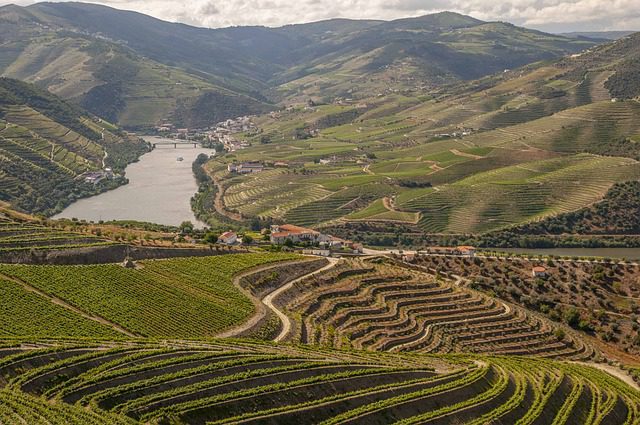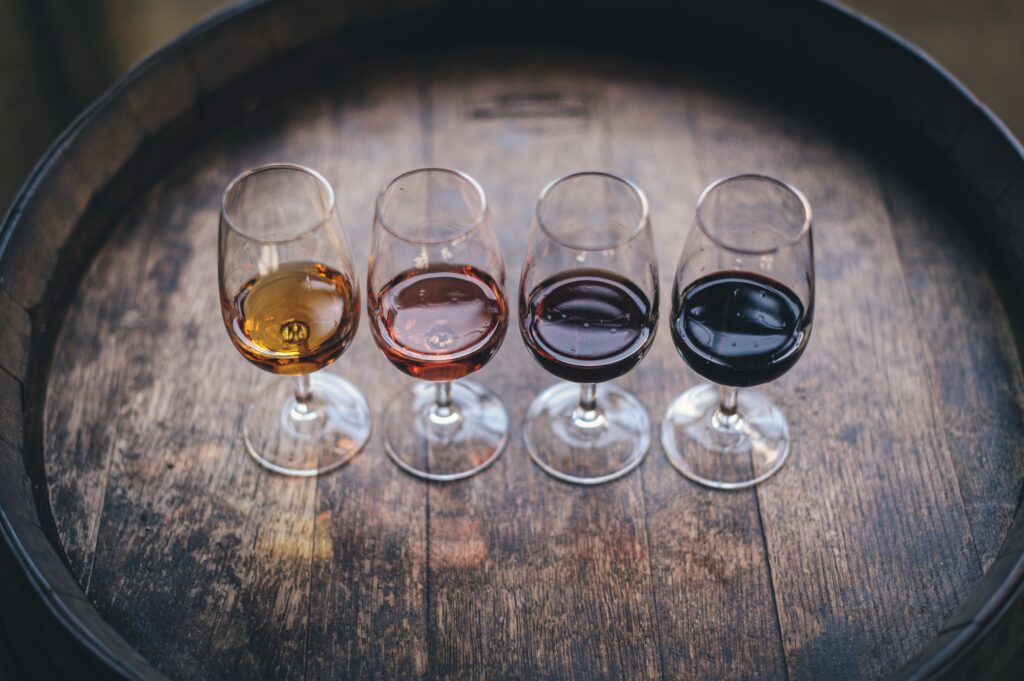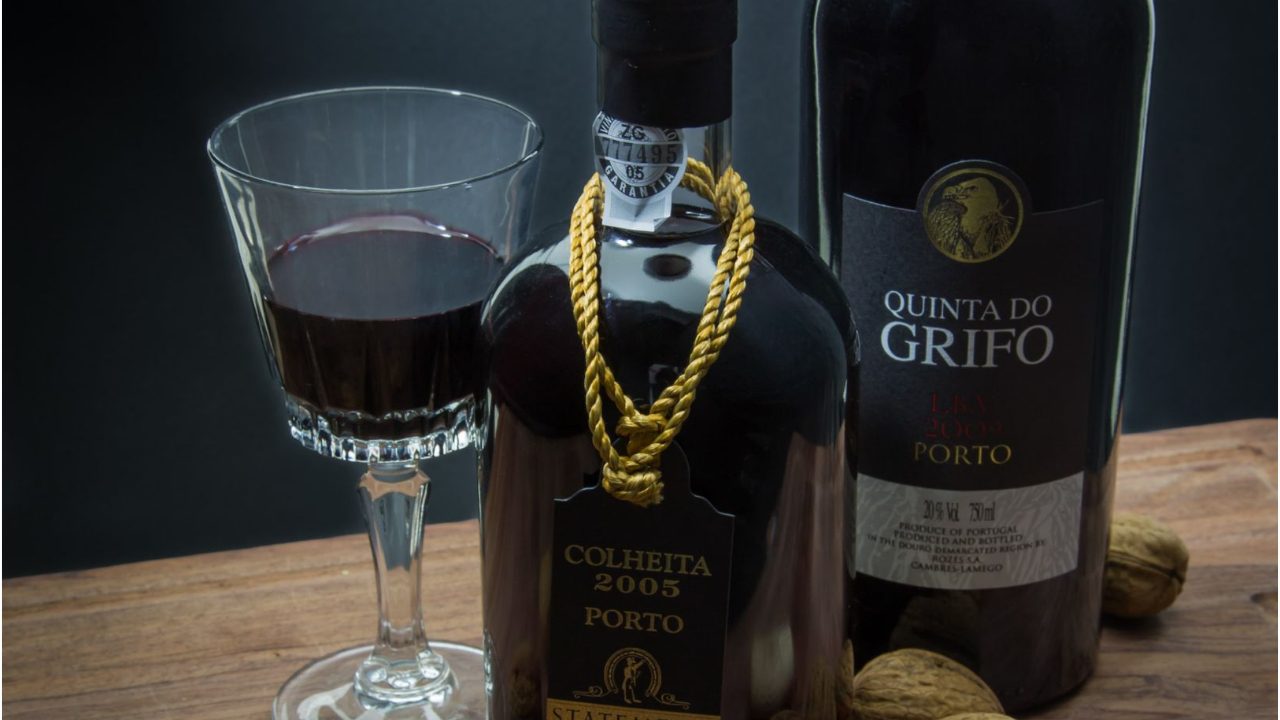Port wine, a celebrated Portuguese dessert wine, is cherished both locally and internationally. This exquisite beverage is crafted from meticulously grown red and white grapes harvested from the steep, sun-kissed slopes of the Douro Valley, a region renowned for its breathtaking beauty and historical significance.
The production of Port wine is a distinctive and intricate process that involves fortifying the wine with brandy, a powerful spirit derived from distilled wine. This method not only elevates the wine’s alcohol content but also preserves the grapes’ natural sugars, resulting in a rich and complex sweetness.
Port wine’s distinctiveness is inherently linked to its origins; only wines from the Douro Valley may bear the Port label. The winemaking traditions in this area are deeply woven into Portuguese culture, with many producers in Porto and Vila Nova de Gaia adhering to age-old techniques. Among these is the ancient practice of foot-treading grapes, an approach revered for its gentle extraction of juice without damaging the seeds, thus safeguarding the grapes’ natural flavors.
The term “Port Wine” is derived from the coastal city of Porto, which boasts a vibrant history. The Douro wine region received formal recognition as an official designation in 1756, when regulations were implemented to ensure the quality and authenticity of the wines produced there. Since then, Port wine producers have diligently upheld high-quality standards, employing a certification seal on their packaging to guarantee the origin and legitimacy of their products. This seal not only assures consumers of authenticity but also embodies the winemakers’ dedication to the enduring tradition and excellence of Port wine—a true treasure of Portuguese viticulture.
Consequently, Port wine is not merely a beverage; it is a reflection of the rich heritage and traditions of the Douro region, showcasing the dedicated efforts of winemakers and their passionate commitment to crafting an unparalleled and distinctive win
Anyone who tries to make you believe that he knows all about wines is obviously a fake.
― Leon Adams
Jump To Section
History of Port Wine
You can also watch this and other exclusive GA Originals on YouTube.
The history of Port wine is a captivating narrative, showcasing centuries of evolution, trade, and cultural significance. Originating from Portugal’s Douro region, this fortified wine can be traced back to Roman times when grapes were first cultivated in the area. However, it was in the 17th century that Port wine truly emerged on the international stage.
Faced with challenges from French wines during the Seven Years’ War, British merchants turned to Portugal for alternatives. Grapes from the Douro, notably the Touriga Nacional, Tinta Roriz, and Tinta Barroca varieties, proved ideal for crafting full-bodied, rich wines. During this time, the practice of adding brandy to wine during fermentation was introduced, resulting in a sweeter, fortified wine that could withstand shipping.
The resulting international acclaim spurred the establishment of several enduring wine houses, such as Taylor’s, Graham’s, and Sandeman. In 2001, the Douro region, celebrated for its stunning landscapes and distinctive wines, was designated a UNESCO World Heritage Site. Its steep, terraced vineyards, traditional winemaking practices, and cellar-aging processes in Porto have become integral to Port’s identity.
Over the years, various Port styles, including Ruby, Tawny, and Vintage, have emerged, each with unique characteristics and production methods. Port wine has become synonymous with celebration, its history marked by innovations and enduring traditions. In recent years, its popularity has surged, not only as an aperitif or digestif but also as a versatile ingredient in cocktails and modern culinary pairings. Port’s legacy continues to evolve while remaining firmly rooted in its rich traditions and the passion of its winemakers. Thus, the history of Port wine weaves together culture, commerce, and a deep-seated love for the Douro vineyards.
About Port Wine

Over 80 grape varieties are used to produce the renowned Port wine, a fortified drink hailing from Portugal’s Douro region. Among the red grapes widely employed in crafting celebrated Ports are several prestigious varieties, including Touriga Nacional, celebrated for its rich aromas and complexity; Tinta Roriz, known for its balanced acidity and sweetness; and Tinta Cão, Tinta Barroca, and Touriga Franca, each adding their distinctive character to the wine’s richness. In the realm of white Port wine, over 30 grape varieties may be utilized, such as Sercial, Malvasia Fina, Viosinho, Rabigato, Gouveia, and Folgasão, which together create a vibrant spectrum of flavors and aromas.
While the Douro region boasts an array of unique grapes, the prevalent method is to harvest, destem, and ferment them together, facilitating a harmonious blend of flavors and characteristics. The foundation of Port wine production closely resembles that of other wines but with one critical difference: during fermentation, before all the sugar is transformed into alcohol, a distillate—typically brandy—is added. This intervention halts fermentation, as the alcohol in the brandy eliminates any remaining yeast, resulting in a wine that retains a notable level of residual sugar.
This fortification process grants Port wine its signature balance of sweetness and dryness while elevating its alcohol content to around 20% by volume. Following fortification, the wine is typically transferred to barrels for aging, although it may be bottled directly in certain instances. While all Port wines possess a sweet profile, the degree of sweetness varies significantly based on aging duration and production techniques, imparting a unique character to each bottle. The primary styles of Port wine include:
Ruby Port

Ruby Port is a fortified wine that originates from the picturesque Douro Valley in northern Portugal and is crafted from a selection of indigenous red wine grape varieties unique to this region. Among these grapes, you’ll find Touriga Franca, known for its aromatic qualities and vibrant red fruit flavors; Touriga Nacional, revered for its full-bodied richness and structure; Tinta Roriz, also known as Tempranillo, which lends depth and complexity; and Tinta Barroca, known for its sweet and fruity characteristics.
Ruby Port is celebrated for its bright, vivid color and pronounced fruitiness, which make it a delightful choice for those who enjoy lively and fresh wines. This style of port is specifically produced to be enjoyed relatively soon after bottling, rather than aged for extended periods. Its youthful exuberance is characterized by flavors of ripe cherries, plums, and blackberries, often complemented by nuances of chocolate and spices.
The winemaking process for Ruby Port typically involves a fermentation period lasting just a few days, during which the grape skins are left in contact with the juice to extract maximum flavor and color. After this short fermentation, the process is halted through the addition of grape spirit, which increases the alcohol content and preserves the wine’s natural sweetness. The resulting Ruby Ports are then aged in large oak vats or barrels for a brief period, which allows them to develop their signature bright and fruity profile while retaining their fresh character.
Ruby Port is perfect for immediate enjoyment, making it an excellent choice for celebrations, after-dinner drinks, or casual gatherings. Whether served slightly chilled on its own or paired with a selection of cheeses, desserts, or chocolate, Ruby Port brings a jubilant spirit to any occasion, inviting you to experience the rich, vibrant flavors of Portugal’s indigenous grape varieties.
Rosé Port
Rosé port is a fascinating variation within the broader category of ruby port, characterized by its distinctive paler hue. This lighter color is achieved by employing a method that involves slightly reduced skin contact during the fermentation process, akin to the techniques used in the production of traditional rosé wines. This nuanced approach to winemaking allows for a more delicate extraction of color while still capturing the essence of the underlying grape varieties.
The flavor profile of rosé port is primarily defined by a vibrant spectrum of red fruit flavors, which includes delightful notes of juicy strawberries, tangy raspberries, and crisp cranberries. The interplay of these fruity elements creates a refreshing and lively tasting experience, making it an enjoyable option for those who appreciate the subtleties of fruit-driven wines.
The lighter and more approachable nature of rosé port makes it an appealing choice for warm-weather sipping or as a delightful accompaniment to a variety of light dishes and desserts. Overall, rosé port beautifully exemplifies how traditional port winemaking techniques can be adapted to create innovative and refreshing expressions that appeal to a wide audience of wine enthusiast
White Port
White port is a unique and delightful fortified wine that is produced using specific varieties of white grapes, which include Rabigato, Viosinho, Malvasia, and Gouveia, among others. These grapes are cultivated in the rich, sun-drenched vineyards of the Douro Valley in Portugal, where the terroir imparts distinct character to the wine.
The resulting flavor profile of white port is truly captivating, reminiscent of succulent fruits such as juicy peaches and ripe apricots. Additionally, it showcases refreshing citrus notes, particularly the bright zest of lemon peel, which adds an invigorating twist to its overall taste.
This combination of fruity and zesty flavors ultimately creates a multi-layered drinking experience that can be enjoyed in various ways, whether sipped on its own, mixed into cocktails, or paired with a variety of dishes. The complexities of the white port not only highlight the craftsmanship involved in its production but also invite wine enthusiasts to explore the nuances of its vibrant palette.
Tawny Port
Tawny Port is a distinctive type of dessert wine that undergoes an extended aging process in wooden barrels, which significantly contributes to its rich and intricate flavor profile. What sets apart the highest quality tawny Ports is their careful maturation in wood, with these exceptional wines often being designated by age categories that indicate their length of barrel aging: 10, 20, 30, or even over 40 years. This aging process allows the wine to evolve and develop a remarkably complex array of flavors and aromas, with characteristics that are quintessential to oxidative wines.
As tawny Ports mature, they accumulate a tapestry of flavors, revealing warm spices that evoke a sense of comfort and nostalgia, along with nutty notes reminiscent of hazelnut. The influence of the barrel aging introduces smooth layers of vanilla, adding a touch of sweetness that complements the wine’s profile.
Furthermore, the rich, dried fruit flavors become prominent, with hints of date, fig, and prune emerging to create a sumptuous experience on the palate. Each sip unveils new depths of flavor, and the longer tawny Ports are permitted to age, the more profound and intricate their characteristics become.
Ultimately, this evolution transforms Tawny Port into a luxurious and indulgent choice for those seeking a truly elevated wine experience, showcasing the artistry of winemaking and the beauty of time spent in the barrel. The combination of these elements results in a wine that is not only delicious but also tells a story of its journey through the years, captivating the senses and leaving a lasting impression.
Vintage Port
Vintage Ports are widely regarded as the most prestigious, expensive, and sought-after expression of Port wine, drawing the attention of connoisseurs and collectors alike. To qualify as a Vintage Port, these exceptional wines must undergo a specific and meticulous aging process. After the grapes are harvested, they are fermented and then aged in oak barrels for a period that typically spans two to three years. This initial aging is crucial, as it allows the wine to develop complexity and character while also enabling the winemaker to assess its potential.
Once the wine has reached the desired profile during barrel aging, it is bottled, marking the start of a new phase in its development. Remarkably, Vintage Ports possess the unique ability to age gracefully, some even for several decades. These wines can mature for an astonishing 40 to 50 years—or even longer—before they reach a point where they are considered fully ready for enjoyment.
This extended aging process contributes not only to the wine’s depth of flavor but also to its aromatic complexity, resulting in an exquisite tasting experience that is highly prized among aficionados. Given their ability to evolve, Vintage Ports offer both immediate pleasure and the promise of thrilling discoveries as they age, making them a truly captivating choice for wine lovers seeking something extraordinary.
Bottom Line
Port wine is a delightful beverage crafted from grapes nurtured on the picturesque slopes of the Douro Valley in Portugal. Its unique winemaking process involves fortification, where brandy is artfully added during fermentation to halt the process and retain the grapes’ natural sweetness. This technique imparts Port wine with its luscious flavor and elevated alcohol content.
Following fermentation, the wine matures in oak barrels or large vats, allowing it to evolve into a complex elixir with captivating aromas. With various aging methods and grape selections, Port wine showcases a spectrum of styles, ranging from vibrant and fruity to rich and full-bodied variations like vintage, tawny, and ruby. Celebrated for its rich history and tradition, Port wine is savored across the globe, often served as an aperitif or paired elegantly with desserts.
Did you like this article?
I hope this article has helped you improve your skills. To learn more, take a look at Sauvignon Blanc: The Enthusiast’s Guide To Wine Lovers.
Leave a comment below and share our content. Help our community grow by following our social media on Spotify, Instagram, Facebook, YouTube, and TikTok. And stay up to date with the news from the world of Gastronomy.
Don’t forget to tag @gastrovinoacademy on Instagram and hashtag it #gastrovinoacademy.
Cheers 🍷


